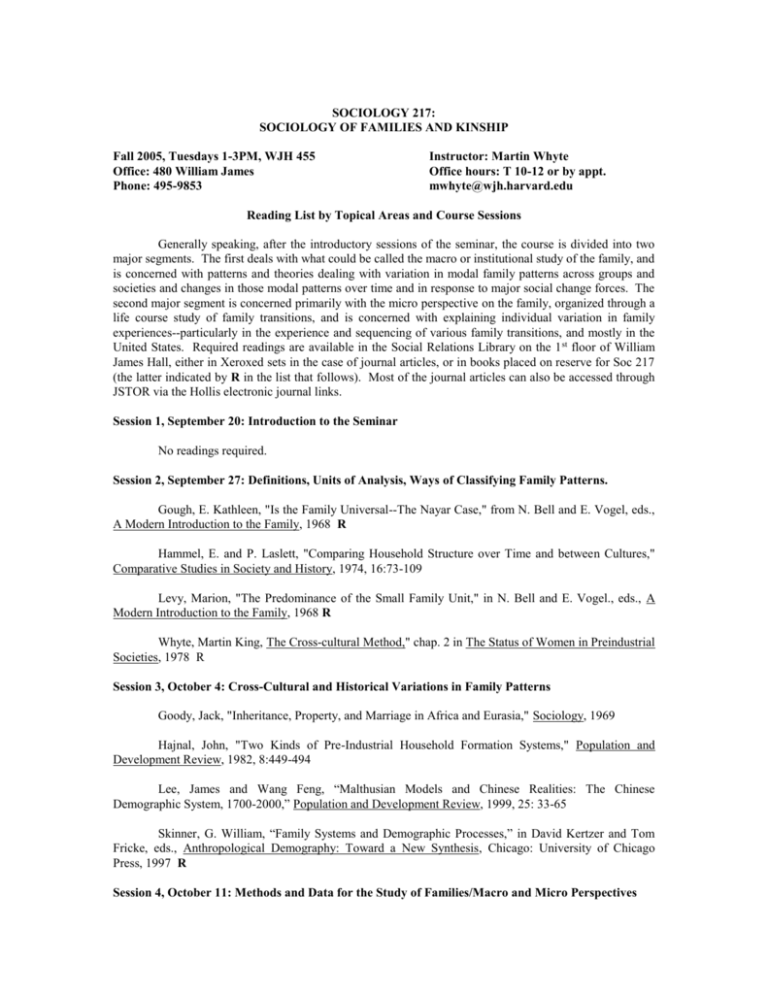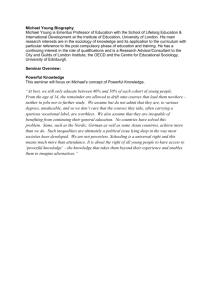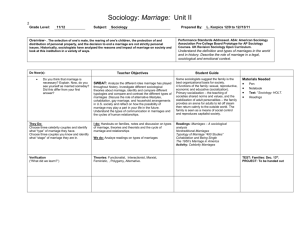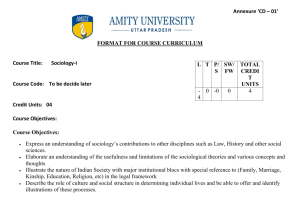
SOCIOLOGY 217:
SOCIOLOGY OF FAMILIES AND KINSHIP
Fall 2005, Tuesdays 1-3PM, WJH 455
Office: 480 William James
Phone: 495-9853
Instructor: Martin Whyte
Office hours: T 10-12 or by appt.
mwhyte@wjh.harvard.edu
Reading List by Topical Areas and Course Sessions
Generally speaking, after the introductory sessions of the seminar, the course is divided into two
major segments. The first deals with what could be called the macro or institutional study of the family, and
is concerned with patterns and theories dealing with variation in modal family patterns across groups and
societies and changes in those modal patterns over time and in response to major social change forces. The
second major segment is concerned primarily with the micro perspective on the family, organized through a
life course study of family transitions, and is concerned with explaining individual variation in family
experiences--particularly in the experience and sequencing of various family transitions, and mostly in the
United States. Required readings are available in the Social Relations Library on the 1 st floor of William
James Hall, either in Xeroxed sets in the case of journal articles, or in books placed on reserve for Soc 217
(the latter indicated by R in the list that follows). Most of the journal articles can also be accessed through
JSTOR via the Hollis electronic journal links.
Session 1, September 20: Introduction to the Seminar
No readings required.
Session 2, September 27: Definitions, Units of Analysis, Ways of Classifying Family Patterns.
Gough, E. Kathleen, "Is the Family Universal--The Nayar Case," from N. Bell and E. Vogel, eds.,
A Modern Introduction to the Family, 1968 R
Hammel, E. and P. Laslett, "Comparing Household Structure over Time and between Cultures,"
Comparative Studies in Society and History, 1974, 16:73-109
Levy, Marion, "The Predominance of the Small Family Unit," in N. Bell and E. Vogel., eds., A
Modern Introduction to the Family, 1968 R
Whyte, Martin King, The Cross-cultural Method," chap. 2 in The Status of Women in Preindustrial
Societies, 1978 R
Session 3, October 4: Cross-Cultural and Historical Variations in Family Patterns
Goody, Jack, "Inheritance, Property, and Marriage in Africa and Eurasia," Sociology, 1969
Hajnal, John, "Two Kinds of Pre-Industrial Household Formation Systems," Population and
Development Review, 1982, 8:449-494
Lee, James and Wang Feng, “Malthusian Models and Chinese Realities: The Chinese
Demographic System, 1700-2000,” Population and Development Review, 1999, 25: 33-65
Skinner, G. William, “Family Systems and Demographic Processes,” in David Kertzer and Tom
Fricke, eds., Anthropological Demography: Toward a New Synthesis, Chicago: University of Chicago
Press, 1997 R
Session 4, October 11: Methods and Data for the Study of Families/Macro and Micro Perspectives
Coontz, Stephanie, “Historical Perspectives on Family Studies,” Journal of Marriage and the
Family, 2000, 62:283-97
Heaton, Tim and Vaughn Call, “Modeling Family Dynamics with Event History Techniques,”
Journal of Marriage and the Family, 1995, 57:1078-90
O'Rand, A. and M. Krecker, "Concepts of the Life Cycle: Their History, Meanings, and Uses in the
Social Sciences," Annual Review of Sociology, 1990, 16:241-62
Ryder, Norman, "The Cohort as a Concept in the Study of Change," American Sociological
Review, 1965, 30:843-61
Session 5, October 18: Myth and Reality in the Study of Past Family Change in the West
Goode, William J., World Revolution and Family Patterns, 1963, Chaps. 1-2 R
Lesthaeghe, Ron and Johan Surkyn, "Cultural Dynamics and Economic Theories of Fertility
Change," Population and Development Review, 1988, 14:1-45
Modell, John, Frank Furstenberg, and Theodore Hershberg, "Social Change and Transitions to
Adulthood in Historical Perspective," Journal of Family History, 1976, 1:7-32 (in M. Gordon, ed., The
American Family in Social-Historical Perspective, 2nd edition, 1978 R)
Smith, Daniel Scott, "The Dating of the American Sexual Revolution: Evidence and
Interpretation," in M. Gordon, ed., The American Family in Social-Historical Perspective, 2nd ed., 1978 R
Thornton, Arland, “The Developmental Paradigm: Reading History Sideways, and Family
Change,” Demography, 2001, 38:449-66
Session 6, October 25: Family Forms and Family Trends Outside the West
Axinn, William and Scott Yabiku, “Social Change, the Social Organization of Families, and
Fertility Limitation,” American Journal of Sociology, 2001, 106:1219-61 [Nepal]
Goode, William J., World Revolution and Family Patterns, 1963 R (any 2 other chapters on world
regions )
Kumagai, Fumie, “Changing Divorce in Japan,” Journal of Family History, 1983, 8:85-108
Whyte, Martin K. "From Arranged Marriages to Love Matches in Urban China," in C. Yi, ed.,
Family Formation and Dissolution: Perspectives from East and West, 1995
Session 7 November 1: Recent Family Trends in Western Societies
Alwin, Duane, "From Obedience to Autonomy: Changes in Traits Desired in Children, 1924-78,"
Public Opinion Quarterly, 1988, 52:33-52
Brewster, Karin, and Irene Padavic, “Change in Gender Ideology, 1977-1996: The Contributions
of Intracohort Change and Population Turnover,” Journal of Marriage and the Family, 2000, 62:477-87
Lesthaeghe, Ron, "The Second Demographic Transition in Western Countries: An Interpretation,"
in Karen Mason and A. Jensen, eds., Gender and Family Change in Industrialized Countries, New York:
Oxford, 1995 R
2
McLanahan, Sara, “Diverging Destinies: How Children are Faring under the Second Demographic
Transition,” Demography, 2004, 41:607-27
Thornton, Arland, and Linda Young-DeMarco, “Four Decades of Trends in Attitudes toward
Family Issues in the United States: The 1960s through the 1990s,” JMF, 2001, 63:1009-37
Session 8, November 8: Variations in Individual Family Transitions: Coresidence and Leaving Home
Glick, Jennifer and Jennifer Van Hook, “Parents’ Coresidence with Adult Children: Can
Immigration Explain Racial and Ethnic Variation?” JMF, 2002, 64:240-53
Goldscheider, Frances and Regina Bures, “The Racial Cross-over in Family Complexity in the
United States,” Demography, 2003, 40:569-87
Marini, Margaret, "Age and Sequencing Norms in the Transition to Adulthood," Social Forces,
1984, 63:229-44
Rindfuss, Ronald, Gray Swicegood, and Rachel Rosenfeld, "Disorder in the Life Course: How
Common and Does it Matter?" American Sociological Review, Dec. 1987, pp. 785-801
Shanahan, Michael, “Pathways to Adulthood in Changing Societies: Variability and Mechanisms
in Life Course Perspective,” Annual Review of Sociology, 2000
Session 9, November 15: Premarital Sexuality, Non-marital Pregnancy
Bearman, Peter, and Hannah Brückner, “Promising the Future: Virginity Pledges and First
Intercourse,” AJS, 2001, 106:859-912
Hofferth, S. J. Kahn, and W. Baldwin, "Premarital Sexual Activity among U.S. Teenage Women
over the Past Three Decades," Family Planning Perspectives, 1987, 19:46-53
Risman, Barbara and Pepper Schwartz, “After the Sexual Revolution: Gender Politics in Teen
Dating,” Contexts, Spring 2002, pp. 16-24
South, Scott, “Historical Changes and Life Course Variation in the Determinants of Premarital
Childbearing,” Journal of Marriage and the Family, 1999, 61:752-63
Session 10: November 22: Premarital Cohabitation
Elwert, Felix, “Causal Effects of Cohabitation on Marital Dissolution: Trial Marriage
Reconsidered,” unpublished paper
Smock, Pamela, “Cohabitation in the United States: An Appraisal of Research Themes, Findings,
and Implications,” Annual Review of Sociology, 2000, 26:1-20
Thornton, Arland, "Cohabitation and Marriage in the 1980s," Demography, Nov. 1988
Whyte, Martin King, Dating, Mating and Marriage, 1990, Chaps 2-4 R
Session 11, November 29: Marriage
Cherlin, Andrew, “The Deinstitutionalization of American Marriage,” Journal of Marriage and the
Family, 2004, 66:848-61
3
Espenshade, Thomas, "Marriage Trends in America: Estimates, Implications, and Underlying
Causes," Population and Development Review, June 1985, pp. 193-245
Manning, Wendy, “Why Marry? Race and the Transition to Marriage among Cohabitors,”
Demography, 1995, 32: 509-20
Oppenheimer, Valerie, "Women's Rising Employment and the Future of the Family in Industrial
Societies," Population and Development Review, 1994, 20:293-342
Session 12, December 6: Work, Particularly Married Women’s Employment Outside the Home
Bianchi, Suzanne, “Maternal Employment and Time with Children: Dramatic Change or Surprising
Continuity?” Demography, 2000, 37:401-14
Davis, Kingsley, "Wives and Work: The Sex Role Revolution and Its Consequences," Population
and Development Review, Sept. 1984, pp. 397-417
Herring, Cedric, and Karen Rose Wilson-Sadberg, "Preference or Necessity? Changing Work
Roles of Black and White Women, 1973-1990," Journal of Marriage and the Family, 1993, 55:314-25
Oppenheimer, V., "Demographic Influence on Female Employment and the Status of Women,"
American Journal of Sociology, January 1973, pp. 946-61
Parcel, Toby and Elizabeth Menaghan, "Early Parental Work, Family Social Capital, and Early
Childhood Outcomes," American Journal of Sociology, 1994, 99:972-1009
Session 13, December 13: Separation, Divorce, and Remarriage
Booth, Alan, et al., "Divorce and Marital Instability over the Life Course," Journal of Family
Issues, 1986, 7:421-42
Cherlin, Andrew, "Remarriage as an Incomplete Institution," American Journal of Sociology, Nov.
1978, pp. 634-50
Previti, Denise and Paul Amato, “Why Stay Married? Rewards, Barriers, and Marital Stability,”
JMF, 2003, 65:561-73
Teachman, Jay and Alex Heckert, "The Impact of Age and Children on Remarriage: Further
Evidence," Journal of Family Issues, 1985, 6:185-203
Whyte, Martin, Dating, Mating, and Marriage, 1990, chaps. 7-8 R
Session 14, December 20: Aging, Retirement, Empty Nests (or Extended Families), and Death
Heaton, Tim and Caroline Hoppe, "Widowed and Married: Comparative Change in Living
Arrangements, 1900 and 1980," Social Science History, Fall 1987, pp. 261-80
Riley, M. W., "Age Strata in Social Systems," in R. Binstock and E. Shanas, eds., Handbook of
Aging and the Social Sciences, 1985 R
Sarkisian, Natalia and Naomi Gerstel, “Kin Support among Blacks and Whites: Race and Family
Organization,” ASR, 2004, 69:812-37
Uhlenberg, Peter, "Death and the Family," Journal of Family History, 1980, 5:313-20
4
Willson, Andrea, Kim Shuey, and Glen Elder, “Ambivalence in the Relationship of Adult Children
to Aging Parents and In-Laws,” JMF, 2003, 65:1055-72
Course Requirements:
The discussion in the first four class meetings will be led by the instructor; in subsequent meetings
of the seminar, responsibility for leading class discussion will be rotated among the students. Depending
upon enrollment, each student will be responsible for helping lead discussion of 3-4 topics over the course
of the semester, with the schedule to be worked out after the 2 nd class session.
No papers are required from the students leading class discussions each week; however, in many
cases handouts with summary points, lists of questions, important data, or other related materials will help
to stimulate discussion, and students are encouraged to prepare and distribute such materials. The best
approach to leading seminar discussions will balance presenting information that was learned (particularly
from readings beyond those required of all students) with stimulating discussion and debate in regard to the
topic of the week.
All students are expected to have read the common readings for each week's session and to be
prepared to discuss the topic for each session. In addition, each student not making a presentation that week
is required, starting in week 5, to think of 1-2 brief critical comments or questions derived from the
common readings for a particular week, and to circulate these to all students in the class and the instructor
by no later than 6pm on the day before that class session (i.e., by Monday at 6pm). A class e-mail alias will
be established for this purpose.
All registered students are also required to write a final seminar paper. Each student is encouraged
to meet individually with the instructor to discuss ideas for the seminar paper as early in the term as
possible, and regularly thereafter. Periodically, portions of a session will be devoted to preliminary
discussions and updates on student seminar paper topics. The schedule for such progress reports will be
announced a couple of weeks in advance. Preliminary presentations of seminar paper results may be
scheduled in an extra session(s) during the reading period, a possibility that will be discussed before the last
scheduled class meeting in December. The seminar papers are due on Tuesday, January 17 th. The course
grade will be calculated as follows: 30% for class presentations during the term; 20% for participation in
general seminar discussions and e-mail exchanges; and 50% for the final seminar paper.
There are no books required for purchase for this seminar. Required readings are available in the
Social Relations Library on the first floor of William James Hall, either in the form of books placed on
reserve (indicated by R in this syllabus) or in Xeroxed copies of specific articles. A supplementary reading
list will be distributed to enrolled students after the 2nd week of class, and some of the books on the
supplementary reading list will also be placed on reserve in the Social Relations Library. Students should
notify the instructor right away if they are having trouble locating any of the assigned readings.
5









